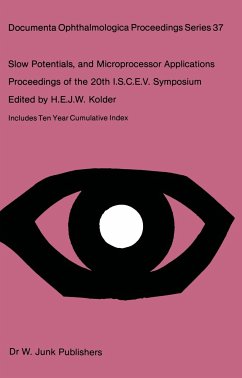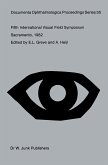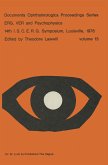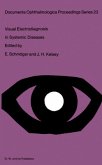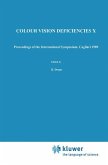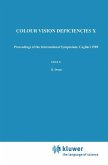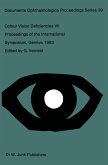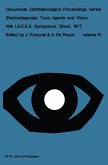Slow Potentials and Microprocessor Applications
Proceedings of the 20th ISCEV Symposium Iowa City, Iowa, U.S.A., October 25¿28, 1982
Herausgegeben:Kolder, H.E.J.W.
Slow Potentials and Microprocessor Applications
Proceedings of the 20th ISCEV Symposium Iowa City, Iowa, U.S.A., October 25¿28, 1982
Herausgegeben:Kolder, H.E.J.W.
- Broschiertes Buch
- Merkliste
- Auf die Merkliste
- Bewerten Bewerten
- Teilen
- Produkt teilen
- Produkterinnerung
- Produkterinnerung
Investigators and clinicians researching and applying electrophysiologic phenomena of the eye, met for the XXth Symposium of the International Society for Clinical Electrophysiology of Vision in Iowa City, Iowa, under the auspices of the University of Iowa and supported by the Department of Ophthalmology, headed by Professor Frederick C. Blodi. Two main topics were discussed: I) Electro-oculography and other slow potentials: the phenomenon, origin, analysis, and clinical diagnosis, and 2) Microprocessor applications for computer-assisted recording and analysis of electro visual phenomena.…mehr
Andere Kunden interessierten sich auch für
![Fifth International Visual Field Symposium Fifth International Visual Field Symposium]() Fifth International Visual Field Symposium41,99 €
Fifth International Visual Field Symposium41,99 €![ERG, VER and Psychophysics ERG, VER and Psychophysics]() ERG, VER and Psychophysics41,99 €
ERG, VER and Psychophysics41,99 €![Visual Electrodiagnosis in Systemic Diseases Visual Electrodiagnosis in Systemic Diseases]() Visual Electrodiagnosis in Systemic Diseases41,99 €
Visual Electrodiagnosis in Systemic Diseases41,99 €![Colour Vision Deficiencies X Colour Vision Deficiencies X]() Colour Vision Deficiencies X242,99 €
Colour Vision Deficiencies X242,99 €![Colour Vision Deficiencies X Colour Vision Deficiencies X]() B. Drum / J.D. Moreland / A. Serra (Hgg.)Colour Vision Deficiencies X243,99 €
B. Drum / J.D. Moreland / A. Serra (Hgg.)Colour Vision Deficiencies X243,99 €![Colour Vision Deficiencies VII Colour Vision Deficiencies VII]() Colour Vision Deficiencies VII161,99 €
Colour Vision Deficiencies VII161,99 €![Electrodiagnosis, Toxic Agents and Vision Electrodiagnosis, Toxic Agents and Vision]() Electrodiagnosis, Toxic Agents and Vision41,99 €
Electrodiagnosis, Toxic Agents and Vision41,99 €-
-
-
Investigators and clinicians researching and applying electrophysiologic phenomena of the eye, met for the XXth Symposium of the International Society for Clinical Electrophysiology of Vision in Iowa City, Iowa, under the auspices of the University of Iowa and supported by the Department of Ophthalmology, headed by Professor Frederick C. Blodi. Two main topics were discussed: I) Electro-oculography and other slow potentials: the phenomenon, origin, analysis, and clinical diagnosis, and 2) Microprocessor applications for computer-assisted recording and analysis of electro visual phenomena. Unusual and challenging diagnostic problems were presented during one evening session. The interest and lively audience participation indicated a need for such an unrehearsed debate. Drs. H.W. Skalka, H. Nakano, H.S. Thompson, A.J. Packer, J.A. Parker, H.E. Kolder, V.M. Hermsen, M.L. Wolf, and Mr. A.1. Mallinson presented case reports and are herewith recognized for their contribution. No documentation is contained in the Proceedings. Several papers were read outside the main topics. Some material appears only as abstract. The highlight of the scientific program proved to be an improvised session on basic mechanisms of slow potentials from the eye. Dr. R.H. Steinberg and his collaborators, together with Dr. G. Niemeyer initiated this part of the program. It was enthusiastically received, provided an informal atmosphere, stimulated a lively discussion and exchanged pro found information. A novel feature of this volume is the addition of a cumulative index covering the Proceedings from the last ten ISCERG-ISCEV Symposia. Dr.
Hinweis: Dieser Artikel kann nur an eine deutsche Lieferadresse ausgeliefert werden.
Hinweis: Dieser Artikel kann nur an eine deutsche Lieferadresse ausgeliefert werden.
Produktdetails
- Produktdetails
- Documenta Ophthalmologica Proceedings Series 37
- Verlag: Springer / Springer Netherlands
- Artikelnr. des Verlages: 978-94-009-7277-3
- Softcover reprint of the original 1st ed. 1983
- Seitenzahl: 520
- Erscheinungstermin: 25. November 2011
- Englisch
- Abmessung: 244mm x 156mm x 28mm
- Gewicht: 814g
- ISBN-13: 9789400972773
- ISBN-10: 9400972776
- Artikelnr.: 39506355
- Herstellerkennzeichnung Die Herstellerinformationen sind derzeit nicht verfügbar.
- Documenta Ophthalmologica Proceedings Series 37
- Verlag: Springer / Springer Netherlands
- Artikelnr. des Verlages: 978-94-009-7277-3
- Softcover reprint of the original 1st ed. 1983
- Seitenzahl: 520
- Erscheinungstermin: 25. November 2011
- Englisch
- Abmessung: 244mm x 156mm x 28mm
- Gewicht: 814g
- ISBN-13: 9789400972773
- ISBN-10: 9400972776
- Artikelnr.: 39506355
- Herstellerkennzeichnung Die Herstellerinformationen sind derzeit nicht verfügbar.
ONE: PHYSIOLOGY OF SLOW RETINAL POTENTIALS.- The Cellular Origin of the Light Peak.- The Cellular Origin of the Fast Oscillation.- Variations of c-Wave Amplitude in the Cat Eye.- Hyperosmolarity-induced Changes in the Transepithelial Potential of the Human and Frog Retinae.- EOG and Experimental Optic Nerve Transection.- Light Modulation of the Standing Potential in the Perfused Mammalian Eye: Characteristics and Responses to Acidosis.- Changes in the Electroretinogram of Albino Rabbits after Intravitreal Injection of DL-?-Aminoadipic Acid.- The Canine c-Wave: Breed and Anesthetic-dependent Variations.- Electroretinogram Below b-Wave Threshold in the Cat: Studies of Retinal Development and Retinal Degeneration.- Abstract: Origin of the Fast Oscillation in the Macaque.- TWO: SLOW RETINAL POTENTIAL APPLICATIONS.- Increment Threshold Function of the Light-Induced Slow Oscillation of the EOG.- Corneoretinal Potentials in Human Infants.- EOG Driven by the Contralateral Reading Eye.- The Electrooculogram in "Vitelliform" Macular Lesions.- EOG Changes in Dominantly Inherited Drusen (Malattia leventinese).- EOG Application for Stargardt's Disease and X-Linked Juvenile Retinoschisis.- Hydroxychloroquine and Retinal Toxicity.- EOG Changes Due to Spontaneous Macular Pucker.- The Fast Oscillation of the Electro-Oculogram, Amplitudes and Latencies in the Course of the Slow Oscillation.- The Fast Oscillation of the Electro-Oculogram in Sectorial Retinitis Pigmentosa.- Changes of the Fast Oscillations in Diabetic Retinopathy in Usage of a New Computerized EOG Device.- Variability of the Human c-Wave.- What Does the c-Wave Tell Us in Retinal Diseases?.- ERG c-Wave at the Early Stage of Diabetic Retinopathy.- The EOG and the ERG in the Aortic Arch Syndrome.- Slow RetinalPotentials Evoked by Patterned Stimuli.- Abstracts: Data to the Electro-Oculography of Retrolental Fibroplasia.- The Long-Term Observation of the ERG c-Wave and EOG in Cases of Postoperative Retinal Detachment.- THREE: MICROPROCESSOR APPLICATIONS.- Interactive Computer Program for Clinical Electrophysiology.- Use of Microcomputers to Acquire Electrophysiological Data: Description of a Commercially Available System in Operation.- Implementation of a Portable Pattern Stimulator and VEP/ERG Recording System Based on an Apple Microcomputer.- Microcomputer Presentation of Patterned Stimuli for Visual Electophysiology.- Microcomputer Technique for Identification of Electrical Biopotentials Transmitted Along the Optic Pathways.- Computer-Assisted Analysis of Clinical Electroretinographic Intensity-response Functions.- Dynamic Random-Element Stereograms: A Microprocessor Application.- Digital vs Analog Filtering of Electrophysiological Data Utilizing Microprocessors.- Abstract: A Microprocessor-Aided Trichromatic Illuminometer Based on General Principles of Retinal Circuitry.- FOUR: PATTERN ERG.- The Distinction Between Luminance and Spatial Contrast Components in the Pattern ERG.- Human Pattern Evoked Retinal Response (PERR): Spatial Tuning and Development.- Pattern Reversal Electroretinograms in Squint Amblyopia, Artificial Anisometropia and Simulated Eccentric Fixation.- Pattern-Reversal Electroretinograms in Unilateral Glaucoma.- FIVE:ERG APPLICATIONS.- Retrolental Fibroplasia and ERG.- On the Recovery of the Electroretinogram of Rats after Removal of Intravitreal Iron Particles.- Electrophysiological and Clinical Findings after Acute Chloroquine Poisoning.- Synchronization of ERG Signs of Retinal Ischemia.- The Actions of Opiates on the Oscillatory Potentials of the Electroretinogram (ERG).- ERG "C"-Wave as Elicited Using Fast Random Stimuli.- Fast Random and Slow Regular Stimulus ERG's in Rabbits after Dilatation with Cyclogel and after Sodium Iodate Injection: A Preliminary Study.- Abstracts: A New Disposable ERG Electrode Utilizing a Hydrophilic Soft Contact Lens with High Water Content.- The ERG in Retinitis Pigmentosa.- Alterations in the Photopic ERG and Optic Atrophy/Dysplasia in Congenital Stationary Nightblindness.- Supernormal Scotopic ERG in Macular Dystrophy.- Amplitude and Latency Changes during Early Diabetes Mellitus in Rats.- SIX: VEP APPLICATIONS.- Luminance Effects on Latency and Topography of Average Pattern-Evoked Potentials.- Oculomotor Behavior in Human Albinos.- Pattern VECP Topography to Right and Left Half Field Stimulation in Intracranial Diseases.- Vector Analysis of Pattern VEP of Patients with Hemianopia.- Early/Late Component Ratio in Pattern-Reversal VEP: Normative Data and Clinical Applications.- Cortical vs Sub-Cortical Components of the Pattern VEP.- Studies on Visual Learning Gain by Means of VEP's.- Pattern Evoked Potential Latency as Indicator of Early and Delayed CNS Changes due to Antileukemia Treatment in Children.- Clinical Application of Hypnotic-Influenced VEP.- Abstracts: Complex Structured Stimuli for VECP.- Asymmetries of VECP Scalp Distribution Evoked by Nasal and Temporal Hemiretinal Stimulation in Esotropic Patients.- The Visual Electrically Evoked Potential (VEEP): Steady State Responses.- SEVEN: MISCELLANEOUS TOPICS.- Implications of Fourier Analysis for Temporal and Spatial Resolution.- An Electronically-Induced Pulfrich Illusion as a Quantitative Measure of Visual Delay and Stereopsis.- Eye Tracking Performance and Attention in Psychotic Patients.- Abstract: ChromaticStimulation in Partial Achromatopsia.- Ten Year Cumulative Index for ISCEV Symposia 1972-1981.
ONE: PHYSIOLOGY OF SLOW RETINAL POTENTIALS.- The Cellular Origin of the Light Peak.- The Cellular Origin of the Fast Oscillation.- Variations of c-Wave Amplitude in the Cat Eye.- Hyperosmolarity-induced Changes in the Transepithelial Potential of the Human and Frog Retinae.- EOG and Experimental Optic Nerve Transection.- Light Modulation of the Standing Potential in the Perfused Mammalian Eye: Characteristics and Responses to Acidosis.- Changes in the Electroretinogram of Albino Rabbits after Intravitreal Injection of DL-?-Aminoadipic Acid.- The Canine c-Wave: Breed and Anesthetic-dependent Variations.- Electroretinogram Below b-Wave Threshold in the Cat: Studies of Retinal Development and Retinal Degeneration.- Abstract: Origin of the Fast Oscillation in the Macaque.- TWO: SLOW RETINAL POTENTIAL APPLICATIONS.- Increment Threshold Function of the Light-Induced Slow Oscillation of the EOG.- Corneoretinal Potentials in Human Infants.- EOG Driven by the Contralateral Reading Eye.- The Electrooculogram in "Vitelliform" Macular Lesions.- EOG Changes in Dominantly Inherited Drusen (Malattia leventinese).- EOG Application for Stargardt's Disease and X-Linked Juvenile Retinoschisis.- Hydroxychloroquine and Retinal Toxicity.- EOG Changes Due to Spontaneous Macular Pucker.- The Fast Oscillation of the Electro-Oculogram, Amplitudes and Latencies in the Course of the Slow Oscillation.- The Fast Oscillation of the Electro-Oculogram in Sectorial Retinitis Pigmentosa.- Changes of the Fast Oscillations in Diabetic Retinopathy in Usage of a New Computerized EOG Device.- Variability of the Human c-Wave.- What Does the c-Wave Tell Us in Retinal Diseases?.- ERG c-Wave at the Early Stage of Diabetic Retinopathy.- The EOG and the ERG in the Aortic Arch Syndrome.- Slow RetinalPotentials Evoked by Patterned Stimuli.- Abstracts: Data to the Electro-Oculography of Retrolental Fibroplasia.- The Long-Term Observation of the ERG c-Wave and EOG in Cases of Postoperative Retinal Detachment.- THREE: MICROPROCESSOR APPLICATIONS.- Interactive Computer Program for Clinical Electrophysiology.- Use of Microcomputers to Acquire Electrophysiological Data: Description of a Commercially Available System in Operation.- Implementation of a Portable Pattern Stimulator and VEP/ERG Recording System Based on an Apple Microcomputer.- Microcomputer Presentation of Patterned Stimuli for Visual Electophysiology.- Microcomputer Technique for Identification of Electrical Biopotentials Transmitted Along the Optic Pathways.- Computer-Assisted Analysis of Clinical Electroretinographic Intensity-response Functions.- Dynamic Random-Element Stereograms: A Microprocessor Application.- Digital vs Analog Filtering of Electrophysiological Data Utilizing Microprocessors.- Abstract: A Microprocessor-Aided Trichromatic Illuminometer Based on General Principles of Retinal Circuitry.- FOUR: PATTERN ERG.- The Distinction Between Luminance and Spatial Contrast Components in the Pattern ERG.- Human Pattern Evoked Retinal Response (PERR): Spatial Tuning and Development.- Pattern Reversal Electroretinograms in Squint Amblyopia, Artificial Anisometropia and Simulated Eccentric Fixation.- Pattern-Reversal Electroretinograms in Unilateral Glaucoma.- FIVE:ERG APPLICATIONS.- Retrolental Fibroplasia and ERG.- On the Recovery of the Electroretinogram of Rats after Removal of Intravitreal Iron Particles.- Electrophysiological and Clinical Findings after Acute Chloroquine Poisoning.- Synchronization of ERG Signs of Retinal Ischemia.- The Actions of Opiates on the Oscillatory Potentials of the Electroretinogram (ERG).- ERG "C"-Wave as Elicited Using Fast Random Stimuli.- Fast Random and Slow Regular Stimulus ERG's in Rabbits after Dilatation with Cyclogel and after Sodium Iodate Injection: A Preliminary Study.- Abstracts: A New Disposable ERG Electrode Utilizing a Hydrophilic Soft Contact Lens with High Water Content.- The ERG in Retinitis Pigmentosa.- Alterations in the Photopic ERG and Optic Atrophy/Dysplasia in Congenital Stationary Nightblindness.- Supernormal Scotopic ERG in Macular Dystrophy.- Amplitude and Latency Changes during Early Diabetes Mellitus in Rats.- SIX: VEP APPLICATIONS.- Luminance Effects on Latency and Topography of Average Pattern-Evoked Potentials.- Oculomotor Behavior in Human Albinos.- Pattern VECP Topography to Right and Left Half Field Stimulation in Intracranial Diseases.- Vector Analysis of Pattern VEP of Patients with Hemianopia.- Early/Late Component Ratio in Pattern-Reversal VEP: Normative Data and Clinical Applications.- Cortical vs Sub-Cortical Components of the Pattern VEP.- Studies on Visual Learning Gain by Means of VEP's.- Pattern Evoked Potential Latency as Indicator of Early and Delayed CNS Changes due to Antileukemia Treatment in Children.- Clinical Application of Hypnotic-Influenced VEP.- Abstracts: Complex Structured Stimuli for VECP.- Asymmetries of VECP Scalp Distribution Evoked by Nasal and Temporal Hemiretinal Stimulation in Esotropic Patients.- The Visual Electrically Evoked Potential (VEEP): Steady State Responses.- SEVEN: MISCELLANEOUS TOPICS.- Implications of Fourier Analysis for Temporal and Spatial Resolution.- An Electronically-Induced Pulfrich Illusion as a Quantitative Measure of Visual Delay and Stereopsis.- Eye Tracking Performance and Attention in Psychotic Patients.- Abstract: ChromaticStimulation in Partial Achromatopsia.- Ten Year Cumulative Index for ISCEV Symposia 1972-1981.

